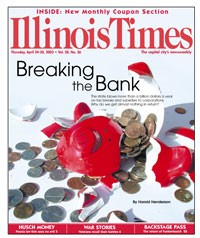On January 13 Governor Rod Blagojevich announced that the state was in danger of spending $5 billion more than it takes in this year. The next day a report appeared criticizing the state for having put hundreds of millions of dollars a year into feel-good economic development programs that aren't paying off. Taxpayers, it made clear, have been paying for giveaways to big business that produce little or no public benefit.
Jeff McCourt and Greg LeRoy's report, "A Better Deal for Illinois: Improving Economic Development Policy," takes a skeptical look at the jumble of business tax breaks and outright subsidies that have passed for an economic development strategy in Illinois. It focuses on two recent tax breaks--including the uninformatively named "Single Sales Factor Formula"--and lays out five high-profile cases in which tax breaks and subsidies were used to entice or keep specific companies: Diamond-Star in 1985 ($249 million), Sears in 1989 ($178 million), Motorola in 1994 ($43 million), Ford in 2000 ($95 million), and Boeing in 2001 ($56 million).
Business subsidies and tax breaks are supposed to be investments, not handouts. In the short run a dollar spent to help business can't be spent on education, roads, parks, or child welfare. The hope is that in the long run money spent to help business will create enough new jobs and build the tax base enough to repay the public, and then some.
But the 89-page report shows that long-term business tax breaks have few demonstrable benefits--and that when the state tries to help a particular company, officials rarely make a careful determination that the business actually needs the help, sometimes overpay when a deal is necessary, and repeatedly fail to monitor the deal afterward to see if the company has delivered the promised benefits.
You might think the report's allegations of imprudent spending would make news given that money's so tight. But they haven't. You have to wonder: would the silence be so complete if similar allegations of government waste had been made about midnight basketball, or Head Start?
The Illinois Department of Commerce and Community Affairs (recently renamed the Illinois Department of Commerce and Economic Opportunity) has been responsible for most of these tax breaks and subsidies. New DCEO director Jack Lavin blames past fiascoes on the "lax policies" of the Ryan administration. Now that Blagojevich is governor, he says, corporate accountability will become a top priority: if companies don't hold up their end of the deals, the state may ask for the return of incentives. It remains to be seen whether Illinois will drive harder bargains at the outset.
• • • • •
The moving force behind "A Better Deal for Illinois" is Ralph Martire, the peppery attorney who heads the Center for Tax and Budget Accountability--a bipartisan Chicago think tank that published the report with Good Jobs First, a nationwide business-subsidy watchdog. Martire is the only person I know whose eyes twinkle when he discusses the way tax breaks affect the state budget: "We're talking about a chunk of money here--a billion dollars a year in tax expenditures for business" alone. And that's not counting the subsidies.
Should tax breaks and subsidies be ditched completely? Martire doesn't think so. "A Better Deal" gives qualified praise to a package involving the City of Chicago and the State of Illinois providing $95 million in subsidies for a manufacturing campus half a mile from Ford's Torrence Avenue assembly plant on the southeast side of Chicago. The report says this deal, still being negotiated, is a potential model because it's expected to create 800 permanent new jobs in Chicago and because it shores up existing jobs at Ford rather than shifting them to distant suburbs. The deal may also require that some of the subsidies be repaid if fewer than 500 full-time jobs are created. "A Better Deal" favors this kind of provision--known as a refund in normal life but called a "clawback" in economic-development circles.
"It may sometimes be a good idea to subsidize business," says Martire. "But these decisions have to be made on good information, and we have to be sure that we get some bang for our buck." That sounds like common sense. If the government hands out money for jobs and the jobs don't materialize, then the government should get its money back.
Because he can see ways to make the system work well for both businesses and taxpayers, Martire declines to follow the lead of many progressives and libertarians, who portray Sears and Motorola and Boeing as welfare queens. And he doesn't bad-mouth business for seeking government handouts. "That's their job," he says. "It's their business to make money. It's our job to make sure that public resources are spent wisely." But as "A Better Deal" shows, that job has gone largely undone for two decades.
• • • • •
In 2001 Boeing announced that it would move its headquarters from Seattle to Dallas, Denver, or Chicago. Governor Ryan and Mayor Daley collaborated in offering the aerospace giant a cornucopia of subsidies and tax breaks if the company would bring its 500 headquarters jobs here. Those subsidies and tax breaks are detailed in "A Better Deal."
The state agreed to give the company $1.5 million outright for technology and capital improvements, $2 million for job training, and $8.6 million toward relocation expenses. The state also offered tax breaks, giving the company a $1 million sales tax exemption and $17 million in corporate income tax credits. Chicago gave Boeing a property tax abatement worth $16 million over 20 years. It also gave the company subsidies of $1 million to buy out the lease of its predecessor, $2 million for energy, and between $4.3 and $6 million to reimburse the company for money spent on taxes to other local governments over 20 years. It also provided a downtown heliport and improvements at Midway to accommodate Boeing's 20-jet fleet.
The total price tag, city and state together, was roughly $56 million. Chicago won the bidding war--but Denver had offered $18 million, Dallas only $14 million. Given the relative size of the bids, you'd have to conclude that Chicago is a terrible place to do business--or that the state and the city paid way too much.
It's hard to say how much the tax breaks and subsidies mattered to Boeing, which at the time had annual revenues of $51 billion. After the deal was done a company official was quoted as saying, "All three cities provided what we would characterize as appropriate packages"--apparently meaning they could have been happy with a lot less. "A Better Deal" concludes that the state and city gave Boeing millions more than they needed to.
But no one was counting as enthusiasm for the deal ran high. The story went that the city would get much more than the 500 headquarters jobs. Arthur Andersen had prepared a study for the state Department of Commerce and Community Affairs claiming, according to a one-page executive summary, that each Boeing headquarters job would generate 1.6 "ripple effect" jobs elsewhere. That's a high figure, given that in 1985 DCCA estimated that each headquarters job at Sears generated just 0.4 jobs elsewhere. Was DCCA right in 1985, or was Andersen's 300-percent-higher figure right in 2001? We can't tell--nor can we evaluate the assertion in "A Better Deal" that Andersen really claimed 5 ripple-effect jobs per headquarters job--because the department has refused to release Andersen's study. "A Better Deal" proposes that the state develop the ability to evaluate these situations consistently on its own and that it disclose all elements of each subsidy or tax-break deal every year--as Minnesota, Maine, and Ohio now do.
"A Better Deal" sees the Boeing deal as overpriced and ill-supported--but not all bad. It didn't encourage urban sprawl, and the city made sure it would get some money back if Boeing didn't come through. On September 12, 2001, Chicago deputy planning commissioner Robert Kunze told the Cook County Board's finance committee that if Boeing headquarters jobs fall below 500 the city will cut the amount it reimburses the company for property taxes. If the number falls below 400 for ten years, the company will have to pay back all the reimbursements. The city's Department of Planning and Development can keep track of this, says spokesman Pete Scales, because it gets annual reports from all businesses that receive benefits from the city, including Boeing.
Sometimes what seem like one-shot deals set dubious precedents. In a high-profile deal back in 1989, the Thompson administration spent $66 million to help Sears move from the Sears Tower in downtown Chicago to a new campus in the northwest suburb of Hoffman Estates. (Some $25 million of that went to build roads to handle additional commuter traffic created by Sears's move out of the Loop.) The state legislature passed a special law allowing Hoffman Estates to establish a tax-increment financing (TIF) district. According to the report, "The TIF changes made it possible for Hoffman Estates to provide Sears with 786 acres of land by issuing $112 million in low-interest TIF bonds, the principal and interest on which was to be repaid out of property taxes paid by Sears." Unlike most new residents, Sears was in effect able to purchase its land merely by paying the property taxes on it. The affluent suburb also got a state enterprise zone--a package of tax breaks for a given geographic area--that reduced Sears's sales, income, and utility taxes by about $6 million.
TIFs and enterprise zones were originally intended to offer tax breaks and subsidies that would encourage businesses to provide jobs in needy areas. But they've since spread indiscriminately across the city and state, in part because of the Sears precedent. According to "A Better Deal," Illinois now has some 780 TIF districts, which every year divert $368 million in property taxes away from general funds. And according to the state comptroller, Illinois has 93 enterprise zones, whose tax breaks cost the state government $53 million in fiscal year 2001. The public purpose of the original programs has been diluted if not mocked. The affluent Chicago suburb of Lake Forest, the report says, may be the only place in the U.S. that has both a TIF district and a Ferrari dealership.
I asked Boro Reljic, vice president for government affairs at the Illinois Manufacturers' Association, about the mission creep in these programs. He chuckled and said, "Imitation is the sincerest form of flattery. Doesn't that just show that these programs work?" Asked whether the proliferation of TIFs and enterprise zones might instead mean that they benefit a few organized interest groups and spread the costs over everyone else, he changed the subject.
As it happens, enterprise zones had already been shown to provide few public benefits. Last year the W.E. Upjohn Institute for Employment Research published a book on them by Alan Peters and Peter Fisher, professors of urban and regional planning at the University of Iowa. They surveyed 75 enterprise zones in 13 states, including Illinois, and found that they "usually cause losses to public coffers," "have very little impact on new investment," and "do little to improve the job prospects" of residents in a zone.
• • • • •
Controversies over giving money to individual companies like Sears and Boeing at least attract public attention. Changes in the business tax code tend to put everyone to sleep, no matter how long lasting, dubious, or costly. "A Better Deal" criticizes several such measures, including an obscure but expensive change in the corporate income tax--the single sales factor mentioned above--that Governor Edgar signed into law in July 1998.
Here's how it works. If a business operates in more than one state, Illinois taxes only the Illinois part of its income. Before 1998 the Illinois part was determined by averaging three things: how much of the company's property was located in Illinois, how much of its payroll was in Illinois, and what share of its sales were made in Illinois. Since 1998 property and payroll no longer count: the Illinois share of corporate income is determined only by how much a company sells in Illinois. As a result companies such as Caterpillar, which have most of their factories and workers here but most of their sales elsewhere, pay less than they did before--which is why "A Better Deal" calls it a "windfall for big manufacturers." Of course it's also true that companies like Ford, with sizable sales in Illinois but relatively few plants and workers here, now pay more in corporate income taxes, a fact the report doesn't mention. But the report is correct that this change has cost the state lots of money.
Before the law was passed, the Illinois Department of Revenue examined previous years' corporate income tax returns and estimated that if the change were made about 7,000 companies would pay less corporate income tax than before and about 7,000 others would pay more--and that overall the state would take in about $95 million a year less. So what was Illinois supposed to get in return for $95 million a year? The answer, once again, was more jobs and a broader tax base. "I think the legislature made a rational decision, a value judgment" when it made sales the only factor in determining corporate income taxes, says the Manufacturers' Association's Reljic. "They want to encourage payroll and property investment here in Illinois." The association commissioned a University of Chicago economist to study an earlier version of the tax change, which was even more generous than the one that became law. That study claimed that the change would lead businesses to generate 155,000 new manufacturing jobs here--a stupefying figure considering that right now Illinois has only around 884,000 manufacturing jobs and the number is dropping.
Exact figures aside, the University of Chicago study implies that this tax change is an important driver of economic development. So five years after it became law can we see any benefit? "Nobody knows how it nets out," Reljic says. "I contend it's impossible to figure." He says there are too many variables involved, and besides, who could reasonably expect new jobs to be created in the middle of a recession? Asked whether he knew if someone was trying to figure out which of these various economic-development incentives really worked, he said, "I don't know anyone who's doing it. I'd put you on to them if I did--it might be more ammunition for my work!"
At least Martire's case is based on some evidence. Every year Site Selection magazine lists the 20 largest new corporate sites and expansions in the country. The Center on Budget and Policy Priorities--a Washington, D.C., think tank--checked the locations of facilities on the list between 1995 and 2000. Of those that moved to states with a corporate income tax, did most go to states that had made changes similar to Illinois'? No, says Martire. "Since 1995, 51 new production facilities worth $700 million or more have relocated. Just 6 of them picked states with single sales factor. If it was such a big factor, you'd expect a higher proportion. In fact, it's irrelevant. What businesses want is good education, transit, transportation, being close to suppliers, quality of life."
Martire was being nice. This tax change can't just be irrelevant--it's either much better or much worse than that. If Illinois is giving up $95 million a year for nothing, then the single sales factor is a fraud, a shell game enabling businesses to get tax-supported public goods without paying for them.
"I'll tell you the best argument against single sales factor," Martire says. "Kraft lobbied for it in Illinois [where its taxes would have gone down]--and against it in Maryland [where its taxes would have gone up]. Do you really think it was good public policy here and not in Maryland?"
• • • • •
Even if every business subsidy and tax break were wiped out tomorrow, the state budget still wouldn't balance. But neither Martire nor "A Better Deal" advocates such a wipeout. They just want accountability. If we're going to pay businesses to create jobs, we should know how much we're paying and what we're getting for it--and who's checking. These days state and federal governments are holding individual welfare recipients accountable for how they use public money and for how long. Will Illinois now start holding businesses to the same standard?




















